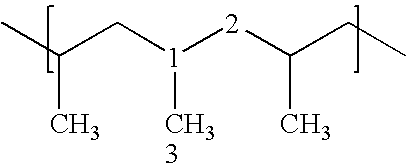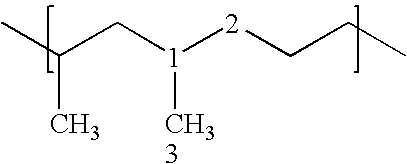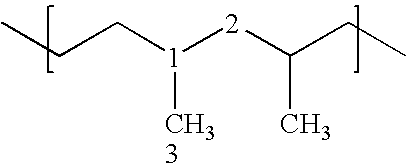Nonwoven fabric and fibers
a technology of nonwoven fabrics and fibers, applied in the field of nonwoven webs or fabrics, can solve the problems of fibers remaining on the skin or clothing of the wearer or others, loss of integrity, and highly undesirable conditions for users, and achieves high levels of strength, softness and abrasion resistance. , the effect of high softness
- Summary
- Abstract
- Description
- Claims
- Application Information
AI Technical Summary
Benefits of technology
Problems solved by technology
Method used
Image
Examples
examples
[0109] A series of nonwoven fabrics was prepared using a spunbond process. The resins were as follows: Resin A is a homopolymer polypropylene having a melt flow rate of 38 gram / 10 minutes commercially available from The Dow Chemical Company as 5D49. Resin B is a polyethylene fiber grade resin made using a Ziegler-Natta catalyst, and having a melt index of 30 gram / 10 minutes and density of 0.955 g / cc. Resin C is a propylene / ethylene elastomer with 12 percent by weight ethylene, having a melt flow rate of 25 gram / 10 minutes and a density of 0.8665 g / cc which was prepared as described in WO03 / 040442. Resin D is a homopolymer polypropylene having a melt flow rate of 25 gram / 10 minutes commercially available from The Dow Chemical Company as H502-25RG. Resin E is a propylene / ethylene elastomer with 15 percent by weight ethylene, having a melt flow rate of 25 gram / 10 minutes and a density of 0.858 g / cc which was prepared as described in WO03 / 040442.
[0110] Nonwoven fabrics were made using ...
example 49
[0124] This Example 49 demonstrates calculation of B values for propylene-ethylene copolymer made using a metallocene catalyst synthesized according to Example 15 of U.S. Pat. No. 5,616,664, using both a conventional interpretation of Koenig J. L. (Spectroscopy of Polymers American Chemical Society, Washington, DC, 1992) and the matrix method, as described above. The propylene-ethylene copolymer is manufactured according to Example 1 of U.S. Patent Publication No. 2003 / 0204017. The propylene-ethylene copolymer is analyzed as follows. The data is collected using a Varian UNITY Plus 400 MHz NMR spectrometer, corresponding to a 13C resonance frequency of 100.4 MHz. Acquisition parameters are selected to ensure quantitative 13C data acquisition in the presence of the relaxation agent. The data is acquired using gated 1H decoupling, 4000 transients per data file, a 7 sec pulse repetition delay, spectral width of 24,200 Hz and a file size of 32K data 10 points, with the probe head heated ...
example 50
[0135] This Example 50 demonstrates calculation of B-values for propylene-ethylene copolymer made using a nonmetallocene, metal-centered, heteroaryl ligand catalyst, such as described in U.S. Patent Publication NO. 2003 / 0204017, which are polymerized using a solution loop polymerization process similar to that described in U.S. Pat. No. 5,977,251 to Kao et al. Table 6 shows the B-values obtained using both a conventional interpretation of Koenig J. L. (Spectroscopy of Polymers American Chemical Society, Washington, DC, 1992), and the matrix method, as described above. As can be seen from Table 6, the propylene-ethylene copolymers of this Example exhibit much higher B-values than those exhibited by copolymers made using a metallocene catalyst.
TABLE 6B-Values of Selected Propylene PolymersRegio-B-ValueB-ValueDensityerrors(Koenig,(Koenig,MFR(kg / dmEthylene14-16 ppmconventionalmatrixNumber(g / 10 min)3#)(wt %)(mole %)method)method)A-18.50.87718.60.671.061.06A-28.30.869211.70.491.081.07A-...
PUM
| Property | Measurement | Unit |
|---|---|---|
| molecular weight distribution | aaaaa | aaaaa |
| weight percent | aaaaa | aaaaa |
| weight percent | aaaaa | aaaaa |
Abstract
Description
Claims
Application Information
 Login to View More
Login to View More - R&D
- Intellectual Property
- Life Sciences
- Materials
- Tech Scout
- Unparalleled Data Quality
- Higher Quality Content
- 60% Fewer Hallucinations
Browse by: Latest US Patents, China's latest patents, Technical Efficacy Thesaurus, Application Domain, Technology Topic, Popular Technical Reports.
© 2025 PatSnap. All rights reserved.Legal|Privacy policy|Modern Slavery Act Transparency Statement|Sitemap|About US| Contact US: help@patsnap.com



